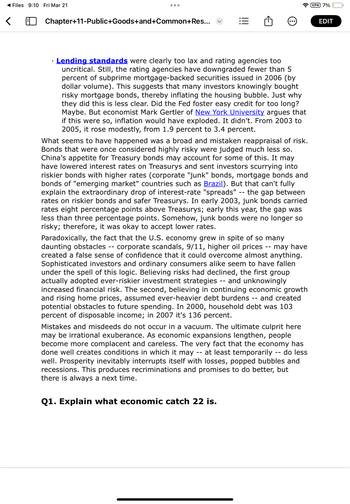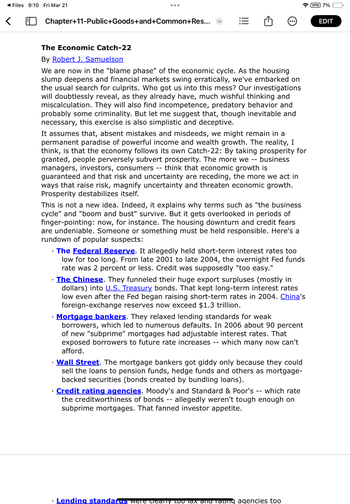
ENGR.ECONOMIC ANALYSIS
14th Edition
ISBN: 9780190931919
Author: NEWNAN
Publisher: Oxford University Press
expand_more
expand_more
format_list_bulleted
Question
Q1 Explain what economic catch 22 is.
Q2 What are the consequences of declining houses pricing?
Q3 What is the argument about necessary evil?
Q4 Explain the idea of irrational exhuberance?
Q5 Explain what was the economic paradox?

Transcribed Image Text:<
Files 9:10 Fri Mar 21
Chapter+11-Public+Goods+and+Common+Res...
...
Lending standards were clearly too lax and rating agencies too
uncritical. Still, the rating agencies have downgraded fewer than 5
percent of subprime mortgage-backed securities issued in 2006 (by
dollar volume). This suggests that many investors knowingly bought
risky mortgage bonds, thereby inflating the housing bubble. Just why
they did this is less clear. Did the Fed foster easy credit for too long?
Maybe. But economist Mark Gertler of New York University argues that
if this were so, inflation would have exploded. It didn't. From 2003 to
2005, it rose modestly, from 1.9 percent to 3.4 percent.
What seems to have happened was a broad and mistaken reappraisal of risk.
Bonds that were once considered highly risky were judged much less so.
China's appetite for Treasury bonds may account for some of this. It may
have lowered interest rates on Treasurys and sent investors scurrying into
riskier bonds with higher rates (corporate "junk" bonds, mortgage bonds and
bonds of "emerging market" countries such as Brazil). But that can't fully
explain the extraordinary drop of interest-rate "spreads" -- the gap between
rates on riskier bonds and safer Treasurys. In early 2003, junk bonds carried
rates eight percentage points above Treasurys; early this year, the gap was
less than three percentage points. Somehow, junk bonds were no longer so
risky; therefore, it was okay to accept lower rates.
Paradoxically, the fact that the U.S. economy grew in spite of so many
daunting obstacles -- corporate scandals, 9/11, higher oil prices -- may have
created a false sense of confidence that it could overcome almost anything.
Sophisticated investors and ordinary consumers alike seem to have fallen
under the spell of this logic. Believing risks had declined, the first group
actually adopted ever-riskier investment strategies -- and unknowingly
increased financial risk. The second, believing in continuing economic growth
and rising home prices, assumed ever-heavier debt burdens - and created
potential obstacles to future spending. In 2000, household debt was 103
percent of disposable income; in 2007 it's 136 percent.
--
--
Mistakes and misdeeds do not occur in a vacuum. The ultimate culprit here
may be irrational exuberance. As economic expansions lengthen, people
become more complacent and careless. The very fact that the economy has
done well creates conditions in which it may at least temporarily do less
well. Prosperity inevitably interrupts itself with losses, popped bubbles and
recessions. This produces recriminations and promises to do better, but
there is always a next time.
Q1. Explain what economic catch 22 is.
--
VPN 7%
EDIT

Transcribed Image Text:<
Files 9:10 Fri Mar 21
Chapter+11-Public+Goods+and+Common+Res...
The Economic Catch-22
By Robert J. Samuelson
We are now in the "blame phase" of the economic cycle. As the housing
slump deepens and financial markets swing erratically, we've embarked on
the usual search for culprits. Who got us into this mess? Our investigations
will doubtlessly reveal, as they already have, much wishful thinking and
miscalculation. They will also find incompetence, predatory behavior and
probably some criminality. But let me suggest that, though inevitable and
necessary, this exercise is also simplistic and deceptive.
--
business
It assumes that, absent mistakes and misdeeds, we might remain in a
permanent paradise of powerful income and wealth growth. The reality, I
think, is that the economy follows its own Catch-22: By taking prosperity for
granted, people perversely subvert prosperity. The more we
managers, investors, consumers - think that economic growth is
guaranteed and that risk and uncertainty are receding, the more we act in
ways that raise risk, magnify uncertainty and threaten economic growth.
Prosperity destabilizes itself.
This is not a new idea. Indeed, it explains why terms such as "the business
cycle" and "boom and bust" survive. But it gets overlooked in periods of
finger-pointing: now, for instance. The housing downturn and credit fears
are undeniable. Someone or something must be held responsible. Here's a
rundown of popular suspects:
· The Federal Reserve. It allegedly held short-term interest rates too
low for too long. From late 2001 to late 2004, the overnight Fed funds
rate was 2 percent or less. Credit was supposedly "too easy."
⚫ The Chinese. They funneled their huge export surpluses (mostly in
dollars) into U.S. Treasury bonds. That kept long-term interest rates
low even after the Fed began raising short-term rates in 2004. China's
foreign-exchange reserves now exceed $1.3 trillion.
Mortgage bankers. They relaxed lending standards for weak
borrowers, which led to numerous defaults. In 2006 about 90 percent
of new "subprime" mortgages had adjustable interest rates. That
exposed borrowers to future rate increases which many now can't
afford.
--
Wall Street. The mortgage bankers got giddy only because they could
sell the loans to pension funds, hedge funds and others as mortgage-
backed securities (bonds created by bundling loans).
Credit rating agencies. Moody's and Standard & Poor's which rate
the creditworthiness of bonds -- allegedly weren't tough enough on
subprime mortgages. That fanned investor appetite.
Lending standards were clearly too lax aliu Tauitg agencies too
VPN 7%
EDIT
Expert Solution
This question has been solved!
Explore an expertly crafted, step-by-step solution for a thorough understanding of key concepts.
Step by stepSolved in 2 steps

Knowledge Booster
Recommended textbooks for you

 Principles of Economics (12th Edition)EconomicsISBN:9780134078779Author:Karl E. Case, Ray C. Fair, Sharon E. OsterPublisher:PEARSON
Principles of Economics (12th Edition)EconomicsISBN:9780134078779Author:Karl E. Case, Ray C. Fair, Sharon E. OsterPublisher:PEARSON Engineering Economy (17th Edition)EconomicsISBN:9780134870069Author:William G. Sullivan, Elin M. Wicks, C. Patrick KoellingPublisher:PEARSON
Engineering Economy (17th Edition)EconomicsISBN:9780134870069Author:William G. Sullivan, Elin M. Wicks, C. Patrick KoellingPublisher:PEARSON Principles of Economics (MindTap Course List)EconomicsISBN:9781305585126Author:N. Gregory MankiwPublisher:Cengage Learning
Principles of Economics (MindTap Course List)EconomicsISBN:9781305585126Author:N. Gregory MankiwPublisher:Cengage Learning Managerial Economics: A Problem Solving ApproachEconomicsISBN:9781337106665Author:Luke M. Froeb, Brian T. McCann, Michael R. Ward, Mike ShorPublisher:Cengage Learning
Managerial Economics: A Problem Solving ApproachEconomicsISBN:9781337106665Author:Luke M. Froeb, Brian T. McCann, Michael R. Ward, Mike ShorPublisher:Cengage Learning Managerial Economics & Business Strategy (Mcgraw-...EconomicsISBN:9781259290619Author:Michael Baye, Jeff PrincePublisher:McGraw-Hill Education
Managerial Economics & Business Strategy (Mcgraw-...EconomicsISBN:9781259290619Author:Michael Baye, Jeff PrincePublisher:McGraw-Hill Education


Principles of Economics (12th Edition)
Economics
ISBN:9780134078779
Author:Karl E. Case, Ray C. Fair, Sharon E. Oster
Publisher:PEARSON

Engineering Economy (17th Edition)
Economics
ISBN:9780134870069
Author:William G. Sullivan, Elin M. Wicks, C. Patrick Koelling
Publisher:PEARSON

Principles of Economics (MindTap Course List)
Economics
ISBN:9781305585126
Author:N. Gregory Mankiw
Publisher:Cengage Learning

Managerial Economics: A Problem Solving Approach
Economics
ISBN:9781337106665
Author:Luke M. Froeb, Brian T. McCann, Michael R. Ward, Mike Shor
Publisher:Cengage Learning

Managerial Economics & Business Strategy (Mcgraw-...
Economics
ISBN:9781259290619
Author:Michael Baye, Jeff Prince
Publisher:McGraw-Hill Education